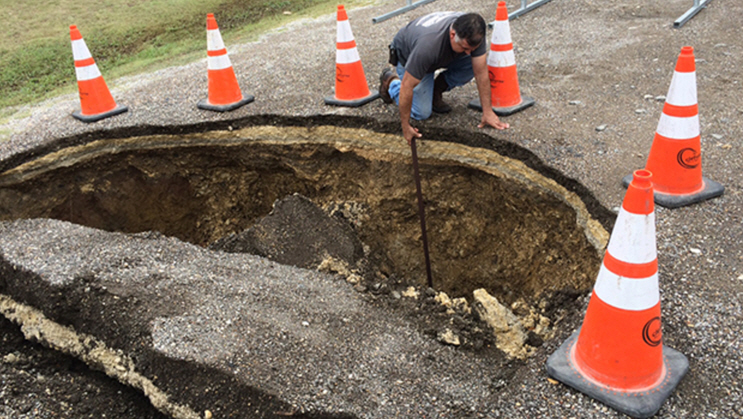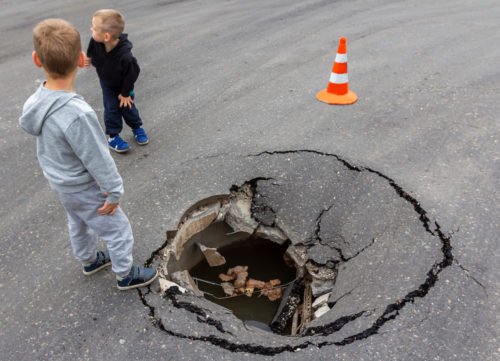Reliable Void Detection with Ground Penetrating Radar (GPR)
Are you concerned about the potential hazards of hidden voids and sinkholes lurking beneath your property? Our expert team at Wood Inspection specializes in Ground Penetrating Radar (GPR) technology, offering top-notch void and sinkhole detection services. With our high-resolution geophysical method, we can accurately investigate underground structures and identify subsurface voids with unparalleled precision. Our non intrusive site investigation application provides clear and detailed information about the presence of voids, offering a cost-effective alternative to traditional intrusive methods.
Protect your property and ensure the safety of your investments by detecting and addressing voids early on. Don’t wait for potential disasters to strike—schedule a void and sinkhole detection consultation with our skilled team today. Safeguard your assets and gain peace of mind with our advanced GPR technology. Let us assist you in securing a stable foundation for your projects. Contact us now and take the first step towards a comprehensive void detection assessment.
What is a Hidden Void Underground?
A hidden void is an undetected, usually air-filled, space within the foundation of structures such as roadways and buildings. These voids can compromise the structural integrity of the areas where they are located and result in physical damage to the road or building as the void is given the opportunity to expand over time.

Inspection of Empty Void Found under Concrete
Voids can be caused by a variety of occurrences, such as the shifting of earth or flow of water underneath a structure that appears sturdy from the exterior. Voids may occur under any established structure and go undetected for years until finally resulting in collapse. Once a foundation has been compromised, the effects can lead to extensive damage to the existing structure, possible loss of life and high costs in repairs.
There are many subsurface voids that might represent critical safety issues and other concerns – washouts or settlement gaps beneath roadways or floor slabs, ungrouted masonry cells, bubbles in concrete pours, tunnels, mine workings, vaults, and incipient sinkholes or soil pipes. All of these can be detected using nonintrusive geophysical techniques.
While the structure itself may have no reason to fail, it can often be what surrounds the structure that makes the difference. Where there is a void, the material may move and settle, undermining the structure over time.
At Wood Inspection Services, we specialize in using GPR for concrete inspections. Providing valuable information about target location or asset evaluation with effective survey results. Whether it’s detecting subsurface voids or conducting concrete inspections, our advanced GPR technology ensures accurate and reliable assessments.
Recent Void Detection Projects by Wood
View full screen map
Can Ground Penetrating Radar Detect Voids?
Absolutely! Ground Penetrating Radar (GPR) is an exceptional tool for detecting voids beneath the surface. By emitting electromagnetic waves into the ground and analyzing the reflected signals, GPR can identify variations in subsurface materials, including air gaps or voids. This technology provides valuable information about the presence and size of voids, helping identify potential risks and prevent structural damage. Making it an ideal choice for void detection in various applications, from construction sites to infrastructure inspections.
Where Can GPR Detect Underground Voids?
Some common areas where void detection is beneficial are under roadways, bridge supports and dwelling foundation stability following heavy rains and flooding. Detecting these unseen hazards provides the opportunity to protect the property from ultimately irreversible damage. In areas of concern, it is best to be proactive and determine the risk of the existence of hidden voids.
Void detection can best be achieved using ground penetrating radar technology and infrared thermography. These methods offer a noninvasive and nondestructive way to investigate subsurface conditions while increasing the safety of the public and protecting both public and private property.
Using non-intrusive techniques to detect voids can aid in reducing further damage to the foundation that would normally result from an invasive method of testing for stability under an established structure. Scanning underground structures in high resolution is much more likely to be preferred to removing multiple sections of foundation to try and locate a possible void.
What Causes Hidden Voids?

Sinkhole in Ground
Common causes of hidden underground voids usually result from heavy rains and flooding or damaged, leaking water pipes. This unexpected influx of water can lead to subsurface areas being washed out or eroded away, leaving the surface structures weakened. These voids can lead to a snowball effect of expanding damage if there is shifting of the earth in the area of the void. While obvious structural issues may not be immediately apparent, significant damage may have occurred deeper down. The longer hidden voids remain undetected, the greater their potential for catastrophic damage and structure failure.
The Most Common Causes of Hidden Voids in Concrete
- Heavy Rains
- Flooding
- Sinkholes
- Buried Organic Materials
- Underground Pipe Leaks
- Cavities
How Voids Are Detected With GPR Technology and Infrared Thermography
The science behind using ground penetrating radar technology is a “non-destructive geophysical device used for subsurface exploration and operated by transmitting an electromagnetic pulse from an antenna into the ground and then capturing the partial reflections from subsurface layers,” according to the Texas Department of Transportation. Potential sinkholes and roadway collapses have been avoided using this method of detection, and that saves money for all involved. Infrared thermography is performed by using high definition thermal imaging cameras. Voids are visible due to having a different heat capacity than the surrounding material. Detecting voids in concrete can be done using infrared thermography and assessing the heat conduction that occurs over the course of a determined amount of time. The lack of intrusive operations and the detailed results make infrared thermography a highly desirable means of hidden void detection.

 Contact Us
Contact Us Call Us
Call Us